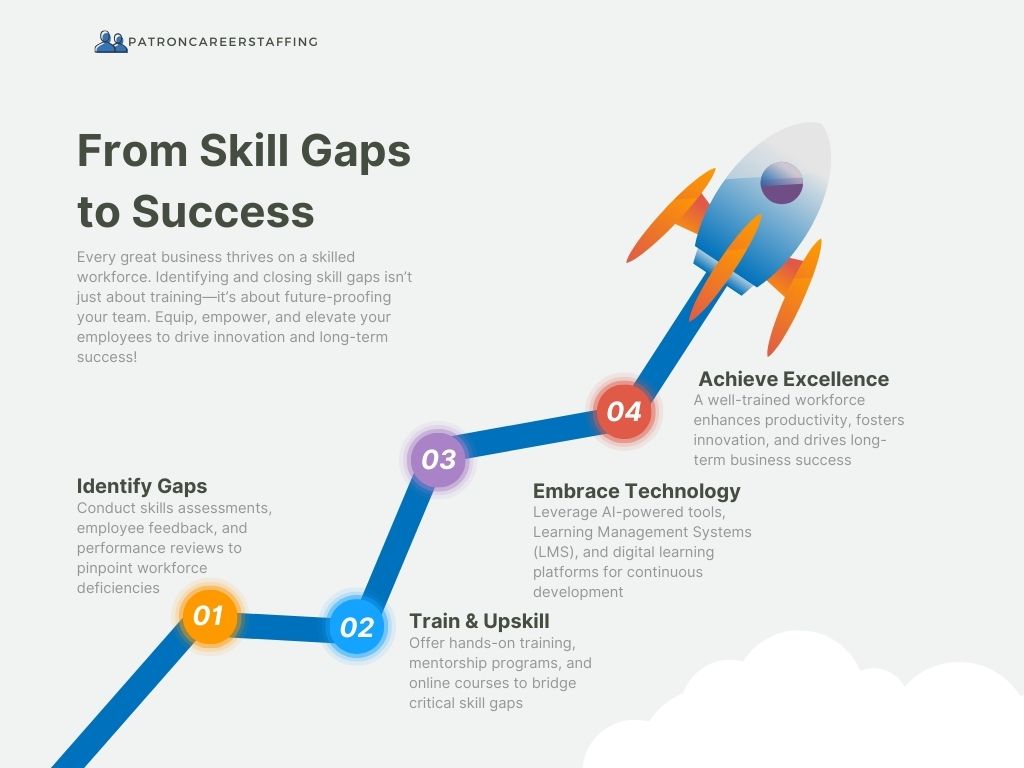Bridging the Skills Gap: How to Identify and Address Workforce Deficiencies
One of the common challenges many businesses face is skill shortages. In Canada’s employment realm, companies need to ensure their workforce has the right skill sets to stay ahead and maintain agility. But what happens when there’s a gap between what employees can do and what the company really needs? That’s where skill analysis becomes useful. Identifying and addressing skill shortages is highly important if your company is aiming for business growth, effective employee development, and maintaining a competitive edge.
In this guide, we’ll cover what skill gaps are, how to spot them ahead of time, what they occur, and how to bridge them to build a future-ready team.
What is a Skill Gap?
A “skill gap” refers to the difference between the skills employees currently possess and the skills they need to acquire to perform their jobs efficiently. Industry advancements, new technologies or evolving job roles often lead to the emergence of these gaps in the workforce. For instance, in a company that adopts AI-driven analytics without training its employees in data interpretation skills, a skill gap would eventually arise. Do not confuse skill gaps with “capability gaps” because the former deals only with skills and the employee’s ability, or knowledge to perform a job is not under scrutiny.
Why Do Skill Gaps Occur?
Before knowing the strategy to identify and address skill gaps, it is worthwhile to understand their root causes. Some of the common reasons are:
- Technological Advancements – Rapid advancements in AI, automation, and software require continuous upskilling.
- Evolving Job Roles – New responsibilities emerge, requiring different skill sets.
- Lack of Training Programs – Without structured learning opportunities, employees may fall behind.
- STalent Shortage – Hiring employees with the right skill set can be challenging.
- Employee Resistance to Change – Some employees may struggle to adapt to new tools and methodologies.
How To Identify Skill Gaps in Your Organization
Let's walk you through the five-step process to perform a skill gap analysis:
1. Conduct A Skills Assessment
Regular assessments help gauge employees’ current skills. Also, before delving into skill identification you should clearly define organizational objectives to better understand what skills are required to achieve these goals. This can include:
- Surveys and Self-Assessments – Employees can report their confidence levels in various skills.
- Performance Reviews – Managers can analyze strengths and weaknesses.
- Skills Tests – Conduct standardized tests to evaluate expertise in critical areas.
2. Analyze Performance Data
Review KPIs, project success rates, and employee productivity levels. If a team consistently struggles with a particular task, there may be a skill gap.
3. Seek Employee Feedback
Encourage open discussions about challenges employees face in their roles. They often have firsthand knowledge of where skill gaps exist.
4. Compare Industry Standards
Benchmark employee skills against industry standards and competitor practices. This highlights areas where employees might be lacking.
5. Evaluate Job Descriptions vs. Actual Capabilities
Compare job descriptions with employees’ current capabilities. If you find a mismatch, it signals a gap that needs to be filled.
Promising Strategies to Address Skill Gaps
Once you identify the potential skill gaps, the next steps include bridging these gaps for maximum employee efficiency. Here are the recommended steps to take:
- Workshops and Seminars – Provide hands-on learning opportunities.
- Online Courses & Certifications – Platforms like Coursera, Udemy, and LinkedIn Learning offer specialized courses.
- Cross-Training Programs – Train employees in multiple areas to build a versatile workforce because- a one-job role isn’t enough anymore!
Willing to learn more about other training modules you can implement to boost your organizational agility, click here.
2. Foster A Learning Culture.
It's the managerial responsibility to create a company culture wherein learning and growth are prioritized. You can significantly enhance skill development by encouraging employees to embrace continuous learning in the form of:
Providing access to learning resources via Learning Management Systems (LMS).
- Promote mentorship programs, allowing senior employees/managers to train others.
- Recognize and reward employee skill development efforts however small.
Related: Career Growth Toolkit: Your Guide to Moving Forward
3. Upskill And Reskill Employees
You can improve employee skills through upskilling and reskilling and build a future- proof workforce. Different roles require different approaches:
- Upskilling – Enhancing and developing an employee’s current skills to match industry trends.
- Reskilling – Training employees for entirely new roles and domains within the organization.
Learn More About The Transforming Power of Reskilling and Upskilling in Driving Business Agility.
4. Invest in Leadership Development
One of the crucial steps to complement the skill development of employees is to invest in leadership training. Managers and team leads should also undergo leadership training to support their teams’ skill development better.
5. Leverage Technology for Learning
Incorporate gamification and microlearning to make learning even easier for employees. Use Learning Management Systems (LMS) and AI-powered training tools to personalize employee learning experiences. For the modern workforce, focus on providing digital training for an immersive employee experience.
6. Hire For Skills, Not Just Experience
Lastly, to combat skill gaps in your workforce, prioritize recruiting candidates with a strong potency to learn and adapt.
What To Do Next
Closing skill gaps is not a one-time effort. It’s a continuous process that demands strategic planning and commitment. To not hit rock bottom, identify skill defines as soon as possible and implement the solutions that we have shared above.
Want to build a more skilled workforce? Go the extra mile in training employees and take your business forward!
We hope you enjoyed reading this article. Don’t forget to subscribe to our newsletter below!






